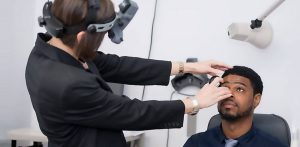What is fourth nerve palsy?
Fourth nerve palsy, also known as superior oblique palsy or trochlear nerve palsy, occurs when the fourth cranial nerve becomes diseased or damaged.
The fourth cranial nerve controls the actions of the superior oblique eye muscle. This external muscle runs from the back of the eye socket to the top of the eye, and is responsible for turning the eye inward and downward.
What causes fourth nerve palsy?
Fourth nerve palsy can be congenital or acquired.
According to a study conducted by the American Academy of Ophthalmology (AAO), the most common type of fourth nerve palsy is congenital (49%), followed by hypertension (18%) and trauma (18%).
Concussions and whiplash are the most common causes of injury to the fourth cranial nerve.
Poor blood flow related to diabetes is another common cause of nerve injury or disease.
Although less common, fourth nerve palsy can also be caused by:
- Vascular disease related to diabetes, that leads to a reduced blood supply to the nerve.
- An aneurysm that is pressing on the nerve and decreasing blood flow to the nerve.
- Increased pressure inside the skull that is pressing on the nerve.
- Stroke
- Brain tumor
Idiopathic fourth nerve palsy occurs when there is no known cause for the nerve paralysis.
What are the symptoms of fourth nerve palsy?
Fourth nerve palsy generally affects only one eye, but it can affect both eyes as well.
The most common symptoms of fourth nerve palsy include:
- Double vision (diplopia) when both eyes are open.
- Strabismus, or an eye turn that causes the affected eye to turn upward.
Other symptoms can include:
- One iris appearing higher than the other
- Tilting the head to compensate for binocular vision difficulties
- Pain above the eyebrow
If you experience any of these symptoms contact an eye doctor near you.
SEE RELATED: Third Nerve Palsy
How is fourth nerve palsy diagnosed?
To diagnose fourth nerve palsy, your eye doctor will first conduct a full medical history.
Your eye doctor will then examine the functioning of the cranial nerves by looking at the position of the eyes at rest, and then evaluating eye movements as an object is followed with the eyes.
Your eye doctor may also assess how your pupils react to light, measure the pressure within your eyes, and examine the back of your eyes with a slit lamp.
Since a range of medical conditions can cause double vision, your doctor may refer you for further testing to rule out any other serious conditions.
These tests may include:
- Blood tests
- Brain imaging
- Eye ultrasound
- Nerve stimulation tests
How is fourth nerve palsy treated?
The treatment options for fourth nerve palsy depend on the underlying cause of the condition.
When fourth nerve palsy is idiopathic or caused by an injury to the nerve, it may improve on its own after several months.
Surgery may be required if something is pressing on the nerve, in order to release the pressure and promote healing.
To reduce or eliminate double vision and improve eye alignment, your eye doctor may prescribe any of the following treatments:
- Vision therapy
- Prism lenses to eliminate double vision
- Eye patching to improve binocular vision
- Surgery to realign the eyes
Vision therapy is an effective treatment option for some patients with fourth nerve palsy, as it can help to improve eye movements and binocular vision.
Your eye doctor may also refer you to a neuro-ophthalmologist, an eye doctor who has undergone extensive training to diagnose and treat various complex conditions and diseases of the nervous system.
LEARN MORE: Guide to Vision Therapy
If you notice any sudden changes to your vision, especially double vision or an eye turn, schedule an eye exam as soon as possible.
The sooner fourth nerve palsy is diagnosed, the greater your chances of optimal treatment results.










